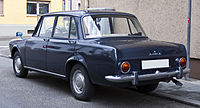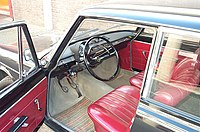
Simca was a French automaker, founded in November 1934 by Fiat S.p.A. and directed from July 1935 to May 1963 by Italian Henri Pigozzi. Simca was affiliated with Fiat and, after Simca bought Ford's French subsidiary, became increasingly controlled by Chrysler. In 1970, Simca became a brand of Chrysler's European business, ending its period as an independent company. Simca disappeared in 1978, when Chrysler divested its European operations to another French automaker, PSA Peugeot Citroën. PSA replaced the Simca brand with Talbot after a short period when some models were badged as Simca-Talbots.

A hatchback is a car body configuration with a rear door that swings upward to provide access to the main interior of the car as a cargo area rather than just to a separated trunk. Hatchbacks may feature fold-down second-row seating, where the interior can be reconfigured to prioritize passenger or cargo volume.

The Rootes Group or Rootes Motors Limited was a British automobile manufacturer and, separately, a major motor distributors and dealers business. Run from London's West End, the manufacturer was based in the Midlands and the distribution and dealers business in the south of England. In the decade beginning 1928 the Rootes brothers, William and Reginald, made prosperous by their very successful distribution and servicing business, were keen to enter manufacturing for closer control of the products they were selling. One brother has been termed the power unit, the other the steering and braking system.
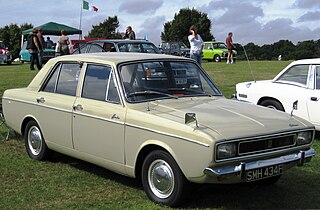
Rootes Arrow was the manufacturer's name for a range of cars produced under several badge-engineered marques by the Rootes Group from 1966 to 1979. It is amongst the last Rootes designs, developed with no influence from future owner Chrysler. The range is almost always referred to by the name of the most prolific model, the Hillman Hunter.

The Hillman Minx was a mid-sized family car that British car maker Hillman produced from 1931 to 1970. There were many versions of the Minx over that period, as well as badge-engineered variants sold by Humber, Singer, and Sunbeam.
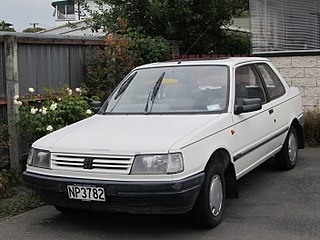
The Peugeot 309 is a small family car that was manufactured between 1985 and 1994 in England, Spain and France by PSA Peugeot Citroën. It was originally intended to be badged as a Talbot and, as development progressed, to be called the Talbot Arizona.

The Hillman Avenger is a rear-wheel drive small family car originally manufactured by the former Rootes division of Chrysler Europe from 1970–1978, badged from 1976 onward as the Chrysler Avenger. Between 1979 and 1981 it was manufactured by PSA Peugeot Citroën and badged as the Talbot Avenger. The Avenger was marketed in North America as the Plymouth Cricket and was the first Plymouth to have a four-cylinder engine since the 1932 Plymouth Model PB was discontinued.

The Talbot Horizon is a compact hatchback that was designed by Chrysler Europe and was produced from 1978 to 1987 under the Simca, Chrysler and Talbot nameplates. The successor to both the Simca 1100 and Hillman Avenger, the Horizon adopted a front-wheel drive, transverse-engine layout.

The Talbot Tagora is an executive car developed by Chrysler Europe and produced by Peugeot Société Anonyme (PSA). The Tagora was marketed under the Talbot marque after PSA took over Chrysler's European operations in 1979. PSA presented the first production vehicle in 1980 and launched it commercially in 1981. The Tagora fell short of sales expectations, described as a "showroom flop" just a year after its launch, and PSA cancelled the model two years later. Fewer than 20,000 Tagora models were built, all of them at the former Simca factory in Poissy, near Paris, France.

The Simca 1307 is a large family car produced by Chrysler Europe and subsequently PSA Peugeot Citroën from 1975 to 1986. Codenamed 'C6' in development, the car was styled in the United Kingdom by Roy Axe and his team at Whitley, and the car was engineered by Simca at Poissy in France.

The Talbot Samba is a city car manufactured by the PSA Group in the former Simca factory in Poissy, France, and marketed under the short-lived modern-day Talbot brand from 1981 to 1986. Based on the Peugeot 104, it and the Talbot Express were the only Talbots not inherited from Chrysler Europe, engineered by PSA alone. It was also the last new Talbot car to be launched. Its demise in 1986 was effectively the end of the Talbot brand for passenger cars. Launched initially as a three-door hatchback, it was also for some time the only small car available in a factory-ordered cabrio body style, and the most economical car in Europe.

Chrysler Europe was the American automotive company Chrysler's operations in Europe from 1967 through 1978. It was formed from the merger of the French Simca, British Rootes and Spanish Barreiros companies. In 1978, Chrysler divested these operations to PSA Peugeot Citroën.

The Chrysler Sunbeam is a small supermini three-door hatchback manufactured by Chrysler Europe at the former Rootes Group factory in Linwood in Scotland, from 1977-81. The Sunbeam's development was funded by a UK Government grant with the aim of keeping the Linwood plant running, and the small car was based on the larger Hillman Avenger, also manufactured there. After the takeover of Chrysler's European operations by PSA, the model was renamed Talbot Sunbeam and continued in production until 1981. A Talbot Sunbeam Lotus version was successful in rallying and won the World Rally Championship manufacturers' title for Talbot in 1981.
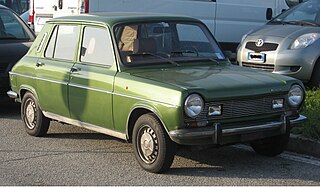
The Simca 1100 is a car built from 1967 to 1982 by Simca. It was replaced by the Simca-Talbot Horizon.

The Matra Murena is a mid-engined, rear wheel drive sports car that was produced from 1980 through 1983 by the French engineering group Matra. The factory was located in the commune of Romorantin-Lanthenay in the department of Loir-et-Cher in central France.

The Chrysler 180 was the base name for a series of large saloon cars produced by Chrysler Europe. Resulting from joining the development efforts of Rootes Group and Simca, the car was produced from 1970 to 1975 in Poissy, France, and later in Chrysler's subsidiary Barreiros' factory in Spain. The Chrysler 180 was also the base for the medium-sized model built by Chrysler Australia, the Chrysler Centura.

The Simca Aronde is an automobile which was manufactured by the French automaker Simca from 1951 to 1964. It was Simca's first original design, as well as the company's first unibody car. "Aronde" means "swallow" in Old French and it was chosen as the name for the model because Simca's logo at that time was a stylized swallow.
France was a pioneer in the automotive industry and is the 11th-largest automobile manufacturer in the world by 2015 unit production and the third-largest in Europe. It had consistently been the 4th-largest from the end of World War II up to 2000. It is 16 % of sales of French manufactured products.

The Simca 1301 and Simca 1501 are two related automobiles which were produced by the French automaker Simca from 1966 to 1975.
The Simca Type 342 and 345 Engines were four-cylinder OHV engines, produced from 1963 through 1975, and used in the Simca mid-size 1501/1301 chassis. It was developed and produced by Simca in the early 1960s to be used in the Simca 1500.


